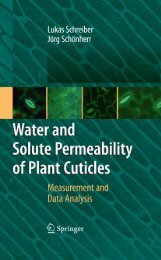Topics in Current Chemistry
Topics in Current Chemistry
Topics in Current Chemistry
Create successful ePaper yourself
Turn your PDF publications into a flip-book with our unique Google optimized e-Paper software.
Electronic Spectroscopy and Photoreactivity of Transition Metal Complexes 123<br />
reactivity (transition dipole moments, sp<strong>in</strong>-orbit coupl<strong>in</strong>g, non-adiabatic<br />
coupl<strong>in</strong>g) cannot be rout<strong>in</strong>ely performed. However the development of efficient<br />
theories and algorithms comb<strong>in</strong>ed with the availability of very fast<br />
computers has enabled such challeng<strong>in</strong>g computations which have to be carried<br />
out with care. The next sections aim at describ<strong>in</strong>g the theoretical procedures<br />
and the most significant developments <strong>in</strong> the field.<br />
2.1<br />
Basis Sets Effects and Effective Core Potentials<br />
Despite the fact that exact atomic orbitals are <strong>in</strong>accessible, atomic orbitals<br />
represent the most suitable set of functions for expand<strong>in</strong>g molecular orbitals<br />
<strong>in</strong> the LCAO (L<strong>in</strong>ear Comb<strong>in</strong>ation of Atomic Orbitals) formalism. In nearly<br />
all ab <strong>in</strong>itio calculations reported today basis sets of contracted Gaussians<br />
are used. In order to be adapted to excited states calculations <strong>in</strong> molecular<br />
systems conta<strong>in</strong><strong>in</strong>g transition metal atoms the basis sets have to be constructed<br />
tak<strong>in</strong>g <strong>in</strong>to account several aspects: i) the various electronic configurations<br />
of the metal centre; ii) the level of calculation; iii) the description of<br />
the outer region of the charge density cloud. Basis sets required for an accurate<br />
description of ground state properties may be <strong>in</strong>adequate for the <strong>in</strong>vestigation<br />
of the electronic spectroscopy. Highly correlated methods such as<br />
MC-SCF, MR-CI or CCSD (T) will need more complete basis sets than s<strong>in</strong>gle<br />
determ<strong>in</strong>antal methods of Hartree-Fock (HF) type. In order to describe correctly<br />
the outer region of the charge density cloud diffuse functions will be<br />
necessary <strong>in</strong> the case of Rydberg states [9]. Polarization functions (basis<br />
functions with L-quantum numbers higher than the valence L-quantum<br />
number) may be important to describe significant displacement of electron<br />
density as <strong>in</strong> Metal-to-Ligand-Charge-Transfer states for <strong>in</strong>stance. The difficulty<br />
is to f<strong>in</strong>d the best compromise between the computational cost and the<br />
accuracy. In this respect the scheme of contraction will be very important.<br />
For second- and third-row transition metal complexes the use of Effective<br />
Core Potentials (ECP) <strong>in</strong>clud<strong>in</strong>g relativistic effects and associated valence<br />
basis sets is a good compromise. For first-row transition metal complexes<br />
Atomic Natural Orbitals (ANO) [10, 11] constructed by averag<strong>in</strong>g the correspond<strong>in</strong>g<br />
density matrix over several electronic configurations (ground<br />
state, valence excited states, positive and negative ions) are required to obta<strong>in</strong><br />
good structural properties, ionisation potentials, electron aff<strong>in</strong>ity and<br />
transition energies. F<strong>in</strong>ally as <strong>in</strong> ground state molecular calculations the<br />
choice of the basis sets associated to the surround<strong>in</strong>g ligands has to be coherent<br />
with the basis sets chosen for the metal centre, especially for a good<br />
description of Metal-to-Ligand-, Sigma-Bond-to-Ligand- or Ligand-to-Metal<br />
Charge-Transfer states. The lower limit as far as the basis sets quality is concerned<br />
for standard correlated calculations (CASSCF, MR-CI, MS-CASPT2<br />
or TD-DFT) <strong>in</strong> middle size transition metal complexes is at least Double-







